When Piloto, Pérez, and Yonder broke off to form Klimax
in 1995, Delgado put together another astounding band, with Jimmy Branly on
drums, José Miguel on timbales and the incomparable Iván
"Melón" González on piano. Melón played
such a critical role in the history of Timba that he has his own artist page,
although he now no longer plays Timba and never had his own group. The first
album with Melón was "El
Año Que Viene" which in addition to a collection of beautiful
melodic songwriting, contains three arrangements which became staple of Issac's
powerful live stage show: "No Me Mires a Los Ojos", "¿Por
Qué Paró?", and "La Vida Sin Esperanza", the latter
arranged by the new musical director, Joaquín
Betancourt, probably the most prolific arranger in Cuba.
Betancourt, whose work on "La Rumba Soy Yo" helped that
CD win a Grammy award, continues to work with Issac today, as well as dozens
of others. His arrangements are featured on the CD's of everyone from Aldaberto
Álvarez to Anacaóna and Tumbao Habana. Click
here to go to the Joaquín Betancourt section of timba.com.
Melón was the only Cuban musician to play on "Otra
Idea" which RMM recorded in New York. It features the original
studio versions of three more classic pieces which Issac still plays live and
which have grown into mammoth 10 to 15 minute arrangements. These are "Luz
Viajera", "Deja Que Roberto Te Toque" and "La Chica del
Sol".
Sometime in late 1996, Issac's band changed dramatically for
the third time and the group that resulted is considered by some to be the greatest
Timba band of all time. Joining Melón was a young musical prodigy named
Alain Pérez, who could sing, write, and play almost any musical instrument
with astounding virtuosity. He played bass in the new band and almost immediately
began contributing arrangements, such as "Con la Punta del Pie" --
a tour de force which we'll examine in detail when we do the real Issac pages.
For now, just listen to it! It, along with two incredible Melón arrangements,
"Se te fue la mano" and "Pa' que te salves" can be found
on "Exclusivo Para Cuba". Here
are some brief audio excerpts: "Se
te fue la mano", "Con
la punta del pie". This album also contains "Tú
tranquilo", which was Issac's vocal contribution to Juan Ceruto's
wonderful "Gracias Formell" project. It was the first arrangement
Ceruto wrote for Issac, but since leaving Paulito in 2001 he has written many
arrangements on Issac's most recent two albums. In the excerpt we hear first
Ceruto's horn-writing and then a great Melón piano tumbao leading into
the coro.
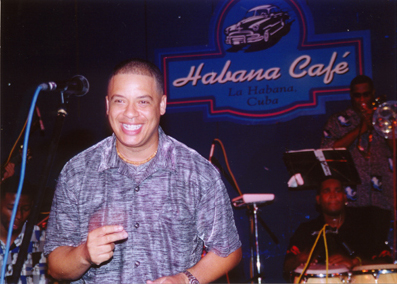 |
| Issac en el Habana Café |
As the name implies, "Exclusivo Para Cuba" was originally released only
in Cuba, but thankfully RMM released it in its entirety (albeit without any
liner notes to speak of) as "Rarities", part of its Forbidden Cuba
in the 90's series. "Rarities" is no longer available, but "Exclusivo
Para Cuba" is no longer exclusive, it is now available in the US on the
Ciocan Music label and is our recommendation as the entry point to the world
of Issac Delgado, along with a front row ticket to see the band perform live!
It was this band that Delgado brought on his controversial
first US tour, and it was this band which played the famous Central Park concert,
about which so many New York musicians, are still buzzing, including New York
Times music critic Peter Watrous, who called Issac Delgado "one of the
best singers in the world -- in any genre" and who still considers this
group to be at the very pinnacle of Timba's long list of amazing Timba bands.
Here are some examples of the group in concert: Luz
viajera,
When Melón moved to Spain, the very capable synthesizer
player, Pepe Rivero, took over on piano and Alain Pérez took full control
of the arranging as well as doing much of the songwriting. The rest of the group
remained largely the same and it was this incarnation of the band that recorded
Issac's final disc for RMM, "La
primera noche". Like most of Issac's discs, it contains lots
of smooth, well-crafted and emotionally satisfying vocal tracks which don't
necessarily sound like hardcore Timba, but, again, it also contains a handful
of numbers which have become staples of Issac's incomparable live concerts,
including "La Sandunguita", "Amigo Juan" and "Que Me
Disculpen" -- all written by Alain Pérez. Here's an excerpt from
a live
version of "La sandunguita". Joaquín Betancourt
wrote the title song and contributed an arrangement, "Amigo", before
returning to a much more active arranging role in the subsequent two albums.
In 1998, Issac returned from a brief residency in Spain, but
most of the band, including Alain Pérez and Issac own sister Daria, stayed
behind. The band is still together today and in 2001 recorded Pérez first
effort as a bandleader and singer, "El
desafío".
Back in Cuba, Issac, undaunted, put together another of Timba's
greatest bands, this time with three key members from Paulito FG's best group:
Joel Domínguez, Joel Paez, and Yaniel "El Majá" Matos.
Tragically this group never recorded, but it played constantly in Cuba through
1999, including a concert atop El Morro which was perhaps the most emotionally
powerful performances I have ever experienced.
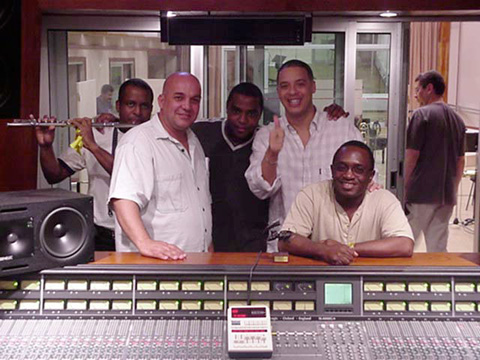 |
| Issac in the studio with Juan Ceruto, Alexander Abreu, Joaquín Betancourt |
The key members of this band left Cuba as well in January of
2000 and Issac brought in, among others, Roberto "Cucurucho" Valdés,
now the pianist with Van Van. In mid-2000 Valdés and Rolando Luna switched
places with Luna coming from Paulito to Issac in a move that also included the
addition of a new musical director, Oscarito Valdés, Jr. Issac also enlisted
services of yet another key member of Paulito FG's group, the brilliant
arranger Juan
Ceruto. It was this band that recorded the grammy-nominated album "La
Fórmula", known as "Malecón" in Cuba. The title
song is arranged by Joel Domínguez and the others are split between the
arranging team of Ceruto & Betancourt. Here's an excerpt from Betancourt's
arrangement of "Malecón".
The album "Grandes Éxitos"
has plenty of great songs, but is far from the best of Issac.
It has only three of the songs we'd include on an Issac Delgado greatest hits
CD. For those looking to buy just one disc, we suggest "Exclusivo Para
Cuba" (aka "Rarities") or "La Fórmula". NG La
Banda's "En la Calle" would also be a good introduction to Issac.
The most recent Issac CD is "Versos
en el cielo". All of the songs are re-arrangements of Cuban
classics from the Nueva Trova era. Issac brought in several New York musicians
to play on the disc, including Ralph Irizarry, who tells us about the experience
in his timba.com
audio interview. Issac also enlisted the talents of nother famous
New Yorker, Jon Fausty, regarded by many as the Latin music world's leading
recording and mixing engineer. The result is one of the most beautiful sounding
Cuban CD's. It's Issac's farthest departure yet from the earthy Timba of his
live performances, but the great arrangements by Ceruto and Betancourt, Fausty's
recording magic, and Issac passionate singing make this album well worth having,
even for the most diehard Timbero. And Issac can't help but sneak some Timba
in, as in this excerpt from the emotionally-charged Betancourt arrangement of
"Vamos a Andar".
2005 - Prohibido
- The reuinion of Issac with Alain turns out to be with an all-New York percussion
section! Go figure. This has been but a brief and wholly inadequate glimpse at
the immense world of Issac Delgado's music, which spans the full range of sonic
color and emotion. We hope to do justice to the task in the near future!
Español: Para apreciar la música de Issac Delgado, es recomendable ver la banda en
vivo. Una muestra indiscriminada de sus temas de estudio más conservadores
podría resultar en la conclusión equivocada de que su música
no es tan enérgica y desafiante como la de las otras bandas timberas.
Esto no podría ser menos cierto, como lo podrán confirmar aquéllos
que hemos asistido a sus conciertos.
El
primer disco de Issac como solista se titula
"Dando la Hora". En
este trabajo se observa buena composición por parte de Piloto y Pablo
Milanés y arreglos peculiarmente sosegados en los cuales se suplen los
instrumentos de viento por sonidos secuenciados de sintetizador. Este disco,
y el disco a dúo con Adalberto Álvarez, "El
Chévere de la Salsa y el Caballero de Son", son
bienvenidos en la colección de aquél que ya adora la música
de Issac, pero a nuestro criterio no representan su mejor trabajo.
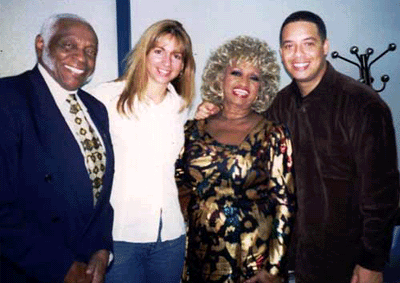 |
| Issac y su esposa junto a Celia Cruz y Pedro N. |
Es con "Con
Ganas" que
Issac vuelve al nivel de calidad que habría demostrado en NG La Banda.
Incorpora de dicha agrupación a Giraldo Piloto para que sirva de baterista
y director musical, y crea el primer grupo tope de los grandes conjuntos de
la timba moderna, con Tony Pérez en el piano, Andrés "Negrón"
Miranda en las tumbadoras , "Yonder", quien luego se incorporaría
a Klímax, en las pailas y Boris Luna, hoy de Los Van Van, en el teclado.
También queremos acotar que el precursor de Piloto en la batería,
aunque nunca grabó un disco entero con el grupo, fue nada menos que Samuel
Formell. La cantidad de músicos brillantes que hicieron escala en el
grupo de Issac Delgado es asombrosa.
Cuando
Piloto, Pérez y Yonder se separan para formar su propio
Klimax en
1995, Delgado reúne a otra agrupación sobresaliente con Jimmy
Branly en la batería, José Miguel en las pailas y el incomparable
Iván "Melón"
González en
el piano. Melón es pieza fundamental en la historia de la timba y cuenta
con una página suya propia en este sitio web, aun cuando ya ha dejado
la timba atrás y nunca tuvo grupo propio. El primer disco con Melón
es "El
Año Que Viene" que
a más de ser una colección de composiciones muy hermosas y melódicas,
contiene tres arreglos indispensables que luego serían aprovechados espectacularmente
durante las presentaciones de Issac: "No me mires a los ojos", "¿Por
Qué Paró?" y "La vida sin esperanza", esta última
servida por el arreglo del flamante director musical Joaquín Betancourt,
probablemente uno de los arreglistas más prolíficos de Cuba. Betancourt,
cuya labor en "La rumba soy yo" fue capital para el galardón
que dicho trabajo obtuvo en los premios Grammy, continúa colaborando
con Issac al igual que con muchos otros artistas más. Sus arreglos aparecen
en todo lado desde las producciones de Adalberto Alvarez y Anacaóna a
Tumbao Habana.
Ingresa
aquí a la sección personal de Joaquín Betancourt
en timba.com
Melón,
por su parte, es el único cubano que participa en "Otra
Idea" lanzado
por la casa disquera RMM en New York. Cuenta con las versiones originales de
estudio de tres obras más que Issac todavía interpreta en vivo
y que han mutado a verdaderos acontecimientos musicales que duran entre 10 y
15 minutos. Estas son "Luz Viajera", "Deja Que Roberto Te
Toque" y "La Chica del Sol".
A fines
de 1996, la banda de Issac cambia drásticamente por tercera vez. Este
grupo, para algunos, resulta ser la mejor banda timbera de todos los tiempos.
A Melón se le suma un genio muy joven llamado Alain Pérez, que
canta, compone y toca cualquier instrumento musical que se le ponga en frente
con un virtuosismo exagerado. En esta oportunidad, Alain toca el bajo y a poco
tiempo empieza a contribuir arreglos, como el de "Con la punta del pie",
un ejemplo excelente de su alta calidad que tendremos la oportunidad de analizar
detenidamente cuando completemos esta sección de Issac Delgado. ¡Por
ahora sólo te queda escucharla con atención! La puedes encontrar,
junto a los dos arreglos formidables de Melón, "Se Te Fue La Mano"
y "Pa' Que Te Salves" en "Exclusivo
Para Cuba". Hemos
incluido, para tu deleite personal, un par de ejemplos de audio:
"Se
te fue la mano", "Con
la punta del pie".
Este disco tiene también "Tú
tranquilo", la canción de Juan Formell que cantó
Issac en el gran proyecto de Juan Ceruto --"Gracias Formell". Era
el primer arreglo que escribe Ceruto para Issac, pero ahora ha escrito varios
otros en los últimos dos discos. Después de la parte de metales
de Ceruto podemos oír un tumbao de piano muy interesante de Melón.
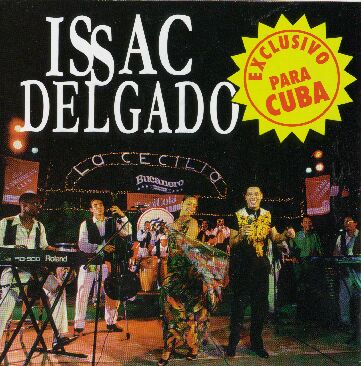 Como
sugiere el título, "Exclusivo Para Cuba" fue lanzado en un
principio sólamente dentro de Cuba, pero gracias a RMM, el disco también
se distribuyó (pero sin mucha información impresa que digamos)
como "Rarities", formando parte de la serie Forbidden Cuba in the
90's. "Rarities" ya no está disponible, pero afortunadamente
"Exclusivo Para Cuba" ya no es exclusivo y es adquirible en los
EE.UU. y es nuestra primera recomendación para conocer el mundo de Issac
Delgado y su grupo ¡junto a una entrada de primera fila para verlos tocar!
Como
sugiere el título, "Exclusivo Para Cuba" fue lanzado en un
principio sólamente dentro de Cuba, pero gracias a RMM, el disco también
se distribuyó (pero sin mucha información impresa que digamos)
como "Rarities", formando parte de la serie Forbidden Cuba in the
90's. "Rarities" ya no está disponible, pero afortunadamente
"Exclusivo Para Cuba" ya no es exclusivo y es adquirible en los
EE.UU. y es nuestra primera recomendación para conocer el mundo de Issac
Delgado y su grupo ¡junto a una entrada de primera fila para verlos tocar!
Fue esta
banda que Delgado trajo a su primera y polémica gira a los EE.UU., y
fue esta formación que se presentó en el famoso concierto de Central
Park, que sigue siendo tema de elogio para tantos músicos neuyorquinos,
incluyendo a Peter Watrous, crítico del New York Times, que no sólo
manifiesta que Issac Delgado "es uno de los mejores cantantes del mundo
actual" pero que también considera a este grupo como la cúspide
de la timba entre una larga lista de asombrosas bandas que han salido de Cuba
en los últimos años. Escuchemos entonces un ejemplo del grupo
en concierto:
Luz
viajera
Cuando Melón
se traslada a España, un tecladista muy hábil y talentoso, Pepe
Rivero, lo reemplaza en el piano y Alain Pérez toma el mando de muchos
aspectos del arreglo y composición de los temas. El resto del grupo permanece
esencialmente intacto y es esta alineación la que graba el último
disco de Issac para la RMM, "La
primera noche". Como
la mayoría de discos de Issac, este ejemplar contiene muchos temas suaves,
coherentes y emocionalmente satisfactorios que no son particularmente la timba
que nos vuelve loco, pero, por otro lado, también podemos entrever algunas
de las canciones ejes del trabajo en vivo, incluyendo "La Sandunguita",
"Amigo Juan" y "Que Me Disculpen" -- todas obra de Alain
Pérez. Escuchen
esta versión
en vivo de "La sandunguita". Joaquín Betancourt
compone el tema titular del disco y contribuye su arreglo de "Amigo"
antes de entablar un papel mucho más activo para la realización
de los próximos discos.
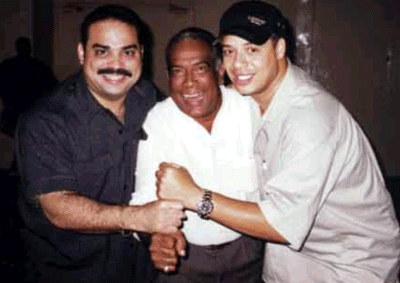 |
| Issac junto a Cheo Feliciano y Gilberto Santa Rosa |
En 1998,
Issac vuelve por un breve lapso a España, y la mayoría de su banda,
incluyendo a su hermana Daria y el mismo Alain Pérez, deciden no volver
a Cuba. Esa banda que se queda atrás permanece junta y en el 2001, Pérez
graba su primer disco como director de orquesta y cantante principal,
"El desafío".
Pero Issac,
que para esto habría vuelto a su isla, aparentemente no siente el golpe
de su repentina carencia de músicos y junta una vez más a otra
de las bandas timberas más grandes de la historia, esta vez con tres
de los miembros claves del equipo musical de Paulito F.G.: Joel Domínguez,
Joel Páez, y Yaniel "El Majá" Matos. Lamentablemente,
este grupo no alcanza a grabar, pero se presenta constantemente en Cuba durante
el 99, en conciertos entre los cuales cabe destacar aquél realizado en
la cima de El Morro. Es probablemente una de las experiencias más palpitantes
que he presenciado en toda mi vida.
Los miembros
importantes de esta banda dejan la isla en enero del 2000 e Issac recruta, entre
otros, a Roberto "Cucurucho" Valdés, pianista actual de los
Van Van. A mediados del 2000, Valdés y Rolando Luna cambian de lugar,
Luna arribando de Paulito en un ajuste que también incluiría la
incorporación de un nuevo director musical, Oscarito Valdés Jr.
Issac también adquiere los servicios de otro miembro clave del
grupo de Paulito FG, el brillante arreglista Juan
Ceruto. Y
esta banda es la que concibe "La
Fórmula", nominada
para el Grammy y conocida también como "Malecón" en
Cuba. El tema titular recibe un excelente arreglo por parte del bajista Joel
Domínguez, y los números restantes son repartidos entre el equipo
arreglista de Ceruto y Betancourt. Este es un extracto de "Malecón"
un arreglo de Joaquín
Betancourt.
El disco
"Grandes Éxitos"
contiene
algunas canciones de buena estampa, pero está lejos de ser lo mejor de
Issac. En realidad sólo incluiríamos tres temas de los que aparecen
en esa compilación si fuésemos nosotros a sugerir lo mejor de
su música. Para los que procuren un sólo disco abarca todo,
tendríamos que inclinarnos hacia "Exclusivo Para Cuba"
(alias "Rarities") o "La Fórmula". "En
la Calle" de NG La Banda también representa una buena introducción
a su espléndida calidad interpretativa.
El disco
más reciente de Issac se titula "Versos
en el cielo". Todos los temas son arreglos nuevos de clásicos
de la Nueva Trova cubana. Issac se trae a algunos músicos de Nueva York
para este disco, incluyendo a Ralph Irizarry, quien nos comenta sobre dicha
experiencia en esta entrevista
de audio para timba.com. Issac también adquiere los servicios
del talentoso Jon Fausty, otro neuyorquino con renombre en el mundo de la música,
considerado por muchos como el primer ingeniero de sonido y grabación
de la música latina. El resultado es uno de los discos cubanos de mejor
fidelidad sonora. Es también lo más distinto que Issac ha hecho
desde sus tenaces presentaciones de timba dura, pero los arreglos fantásticos
de Ceruto y Betancourt, la magia de Fausty, y la apasionante calidad vocal de
Issac hacen de este trabajo una inclusión indispensable en la audioteca
de todo aficionado de la música cubana, incluyendo al adepto timbero
más ferviente. En todo caso, Issac no pudo dejar la timba dura del todo
atrás, como, gracias al poderoso arreglo del maestro Betancourt, lo percibimos
en este ejemplo de "Vamos a Andar".
Hemos sido
muy breves. Este vistazo le queda cortísimo al inmenso mundo de Issac
Delgado y su concepto, que en sí abarca toda la gama de emociones y expresiones
musicales. ¡Esperamos encarar este desafío en un futuro muy cercano!


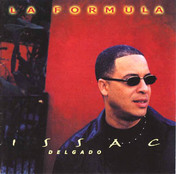






 Como
sugiere el título, "Exclusivo Para Cuba" fue lanzado en un
principio sólamente dentro de Cuba, pero gracias a RMM, el disco también
se distribuyó (pero sin mucha información impresa que digamos)
como "Rarities", formando parte de la serie Forbidden Cuba in the
90's. "Rarities" ya no está disponible, pero afortunadamente
"Exclusivo Para Cuba" ya no es exclusivo y es adquirible en los
EE.UU. y es nuestra primera recomendación para conocer el mundo de Issac
Delgado y su grupo ¡junto a una entrada de primera fila para verlos tocar!
Como
sugiere el título, "Exclusivo Para Cuba" fue lanzado en un
principio sólamente dentro de Cuba, pero gracias a RMM, el disco también
se distribuyó (pero sin mucha información impresa que digamos)
como "Rarities", formando parte de la serie Forbidden Cuba in the
90's. "Rarities" ya no está disponible, pero afortunadamente
"Exclusivo Para Cuba" ya no es exclusivo y es adquirible en los
EE.UU. y es nuestra primera recomendación para conocer el mundo de Issac
Delgado y su grupo ¡junto a una entrada de primera fila para verlos tocar!
